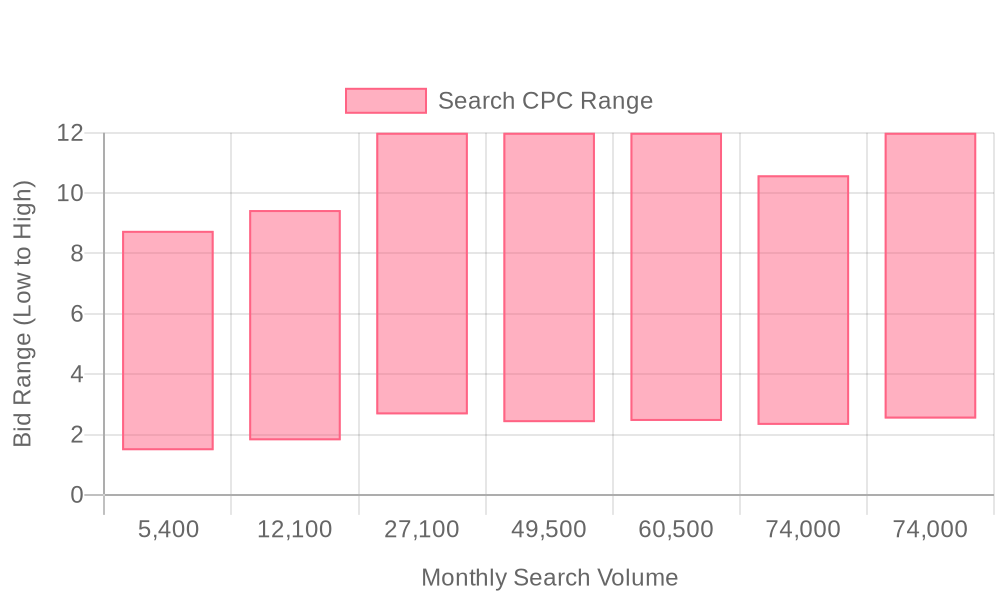
Supercharge your lead generation with a FREE Google Ads audit - no strings attached! See how you can generate more and higher quality leads
Get My Free Google Ads AuditFree consultation

No commitment
Supercharge your lead generation with a FREE LinkedIn Ads audit - no strings attached! See how you can generate more and higher quality leads
Get My Free Google Ads AuditFree consultation

No commitment
Supercharge your lead generation with a FREE Meta Ads audit - no strings attached! See how you can generate more and higher quality leads
Get My Free Google Ads AuditGet My Free LinkedIn Ads AuditGet My Free Meta Ads AuditFree consultation

No commitment
Supercharge your lead generation with a FREE Google Ads audit - no strings attached! See how you can generate more and higher quality leads
Get My Free Google Ads AuditFree consultation

No commitment
In today's complex marketing landscape, effective B2B marketing necessitates a strategic mix of both online and offline channels working in concert. Online channels like social media build digital brand awareness, while email marketing nurtures ongoing relationships, and SEO drives organic visibility. Meanwhile, offline channels such as trade shows generate face-to-face connections, direct mail creates tangible touchpoints, and industry publications establish thought leadership. Within this integrated ecosystem, Google Ads plays a critical middle-funnel role by capturing high-intent prospects at the precise moment they're searching for solutions—bridging the gap between broader awareness efforts and your sales process. For medical service providers, Google Ads represents a powerful opportunity to integrate online and offline marketing efforts: \n- Intercept decision-makers at their exact moment of need, whether they're following up after a medical conference or responding to an email newsletter.\n- Target with precision using technical specifications and specialized terminology unique to medical services.\n- Measure ROI completely by tracking from click to appointment request to closed booking, connecting digital touchpoints with offline interactions.\n- Complement other channels through remarketing to medical publication readers, event attendees, and digital audiences alike.

Healthcare organizations and B2B marketers face increasing competition as patients rely on digital channels for provider selection. Efficient lead generation demands a data-driven strategy that aligns paid search with a unified marketing approach, ensuring every ad dollar delivers measurable impact—explore actionable strategies in our marketing analytics blog or get started for free with Sona.
This playbook is engineered for healthcare providers, B2B revenue teams, and medical facilities seeking to capture qualified patient leads. The focus is on harnessing Google Ads for General Medical Services within a multi-channel strategy, leveraging precise targeting, compliant messaging, and actionable analytics to maximize ROI and patient acquisition. For a comprehensive overview of Google Ads' advertising policies, ensure your campaigns meet compliance requirements.
This step-by-step framework equips healthcare marketers and revenue teams with the tactical precision, compliance knowledge, and data integration capabilities required to generate leads efficiently with Google Ads for healthcare marketing.

Digital marketing for medical services demands precise outreach, measurable results, and agility in responding to patient needs. Google Ads delivers these advantages by enabling healthcare marketers to engage patients right when they are actively searching for specialized care, consultations, or urgent medical support. For a comprehensive look at advertising requirements, review Google Ads' healthcare advertising policies.

Ready to optimize your next campaign? Get started for free with Sona.
Identifying untapped growth areas requires a strategic approach tailored to the complexities of general medical services. Revenue leaders excel by bridging the gap between conventional marketing tactics and precise, data-driven expansion opportunities.
Ready to act on these insights? Get started for free with Sona.

Precision in audience segmentation forms the backbone of effective healthcare marketing. Tailoring campaigns to specific patient needs ensures that ad spend is allocated where it has the highest potential for conversion, maximizing both reach and budget efficiency. For more insights on data-driven healthcare campaigns, explore using Google Ads and Facebook Ads in marketing your medical practice.
Ready to maximize your healthcare marketing impact? Get started for free with Sona.

| Industry | Keyword | Monthly Search Volume | Competition Level | Low Bid | High Bid |
| General Medical Services | primary care doctors accepting new patients | 5400 | LOW | 1.48 | 8.75 |
| General Medical Services | primary care doctors near me accepting new patients | 12100 | LOW | 1.81 | 9.44 |
| General Medical Services | primary care doctor | 27100 | LOW | 2.67 | 12 |
| General Medical Services | primary care doctor near me | 49500 | LOW | 2.41 | 12 |
| General Medical Services | primary care physician | 60500 | LOW | 2.45 | 12 |
| General Medical Services | primary care physician near me | 74000 | LOW | 2.32 | 10.59 |
| General Medical Services | primary care near me | 74000 | LOW | 2.53 | 12 |
Healthcare providers face a unique challenge: they must engage patients at the precise moment those individuals are actively seeking care. Google Ads empowers medical practices to capture high-intent leads—patients researching symptoms, treatments, or providers—by aligning ad visibility with critical decision points.
A robust keyword strategy is essential for targeting these motivated prospects. For medical services, focus on terms that reflect urgent needs and specific conditions, as well as location-based searches that indicate readiness to book. For example:
Building keyword lists around these terms allows medical practices to intercept decision-makers precisely when they are searching for a solution. Leveraging real-time audience intent, teams can prioritize high-conversion audiences and adjust bidding strategies for maximum efficiency. As leads engage with your ads and website, advanced platforms can identify not just anonymous traffic but also the companies and individuals behind each visit, providing granular insights for future targeting.
Continuous refinement is crucial for maintaining campaign performance and compliance. Dynamic audience updates, powered by integrated CRM and ad platforms, ensure that targeting remains accurate as patient needs evolve. This approach delivers measurable ROI by connecting every click, consultation, and outcome—enabling healthcare marketers to optimize spend and prove value across the entire funnel. For those seeking additional strategies on refining their approach, consider exploring Google Ads' advertising policies to ensure ongoing compliance.
Ready to reach more high-intent patients? Get started for free with Sona.
Building a precise keyword list is foundational for Google Ads for General Medical Services. Start by clustering terms based on service types, such as general check-ups, diagnostics, or specialized treatments. This segmentation ensures campaigns reach patients searching for specific care options. Localize each cluster with geographic modifiers including city, neighborhood, and "near me" phrases, which connect your ads to patients actively seeking nearby providers.
Expand coverage by including long-tail and question-based queries aligned with how real patients search, such as "best pediatrician near me" or "how quickly can I get a physical exam." Negative keywords are essential to eliminate irrelevant clicks, like excluding "free medical advice" or unrelated treatments, maximizing budget efficiency. Aligning keyword choices with the language used in your educational content and patient communications builds consistency and supports higher ad relevance. When teams leverage unified data from platforms like Sona, they can surface high-converting search terms based on real-time visitor and engagement data, ensuring campaigns are always tuned to actual patient intent. To learn more about keyword and campaign strategy, visit our blog for B2B marketers.
Effective ad copy for healthcare marketing must address patient pain points and provide immediate value. Headlines should reference patient concerns—such as fast appointment scheduling, trusted expertise, or specialized care—making each ad resonate with real needs. Trust signals, including board certifications, patient testimonials, and successful treatment stories, should be featured prominently to build credibility and reduce friction in the decision process.
Urgency is a powerful motivator: highlight limited-time incentives like free consultations or same-day appointments. Ad extensions, including call buttons, structured snippets, and service highlights, increase engagement and provide additional touchpoints for prospective patients. Maintaining consistent messaging across Google Ads, email, and social campaigns ensures a unified patient journey. With a connected platform like Sona, marketers can dynamically update ad messaging as patients move through the funnel, so high-intent audiences see the most relevant offers and value propositions at every touchpoint. For a detailed overview of ad policies and approval processes, review Google’s ad policies resource.
Landing pages for medical services must tightly align with both the keywords and the ad creative that brought the visitor in. Create dedicated pages for each service line or specialization, such as pediatrics, urgent care, or chronic disease management, to deliver highly relevant experiences. Incorporate ROI calculators for elective procedures, trust badges (such as accreditations or awards), and detailed FAQs to address common concerns and reduce barriers to conversion.
Calls to action should remain prominent and accessible on every device, making booking an appointment or requesting more information seamless. Persistent, clear CTAs drive higher engagement from mobile and desktop visitors alike. Integrating forms with your CRM and marketing automation tools ensures lead capture is immediate and actionable. Solutions like Sona facilitate this connection, syncing enriched lead data from landing page submissions directly into your CRM, enabling instant follow-up and nurturing based on the visitor's demonstrated interest and behavior. For practical landing page tips and strategies, explore our marketing playbooks.
Optimizing Google Ads for healthcare requires a disciplined focus on both micro and macro conversions—track everything from call clicks and form submissions to actual appointment bookings. Utilize smart bidding strategies such as Target CPA or Max Conversions to let machine learning allocate budget toward traffic most likely to convert. A/B testing should cover ad headlines, CTA placements, and landing page layouts, allowing you to continually refine for higher performance.
Importing offline conversions, such as in-office appointment completions, provides a holistic view of ROI and enables smarter bid adjustments. Feeding this data into your optimization loop reveals which keywords and campaigns drive real revenue, not just clicks. Platforms like Sona empower revenue teams with real-time, cross-channel insights—using Google Ads performance to inform content creation, audience segmentation, and future campaign strategy for sustained improvement in patient acquisition and retention. If you're ready to elevate your campaign execution, get started for free with Sona.
Navigating the world of Google Ads for general medical services can seem daunting, but it is an essential strategy for modern medical practices looking to expand their reach and effectively attract new patients. By understanding the nuances of online advertising, including the specific policies and guidelines tailored to the healthcare sector, you can leverage these platforms to your advantage.
Throughout this article, we've explored the critical aspects of utilizing Google Ads to enhance your medical practice's online presence. From grasping the importance of crafting compliant and impactful ad copy to employing targeted strategies that resonate with potential patients, these insights are designed to help you optimize your advertising efforts. By aligning your ads with the needs of your audience, you can drive engagement and ultimately grow your practice.
Imagine the potential growth and patient engagement that efficient Google Ads management could bring to your medical practice. By embracing these strategies, you're not just staying competitive; you're setting the foundation for sustained success. With the right approach, your practice can stand out in the crowded healthcare market, offering quality care to those who need it most.
To explore how we can assist you in achieving these goals, start for free to experience our platform and its capabilities today. This is your opportunity to transform your advertising efforts and see tangible results in your practice's growth and patient outreach.
Setting up Google Ads for your medical practice involves building targeted keyword lists based on service types, developing compelling ad copy that addresses patient needs, designing effective landing pages that align with your ads, and implementing data-driven optimizations for continuous improvement.
Google Ads policies for healthcare providers require compliance with advertising standards, including accuracy in claims and trust signals such as medical accreditations. For a comprehensive overview, healthcare providers should review Google's advertising policies.
You can target local patients by using geo-targeting techniques such as adding city or 'near me' modifiers to your keyword lists, ensuring your ads reach patients actively seeking nearby providers.
Best practices include precise keyword targeting, compelling and compliant ad copy, optimized landing pages, and integrating online and offline conversion tracking to measure ROI and improve campaign performance.
To make Google Ads HIPAA compliant, ensure that any personal health information is protected, avoid using sensitive health data in your ads, and follow Google's advertising policies and HIPAA guidelines.
Join results-focused teams combining Sona Platform automation with advanced Google Ads strategies to scale lead generation

Connect your existing CRM

Free Account Enrichment

No setup fees
No commitment required

Free consultation

Get a custom Google Ads roadmap for your business
Join results-focused teams combining Sona Platform automation with advanced Meta Ads strategies to scale lead generation

Connect your existing CRM

Free Account Enrichment

No setup fees
No commitment required

Free consultation

Get a custom Google Ads roadmap for your business
Join results-focused teams combining Sona Platform automation with advanced LinkedIn Ads strategies to scale lead generation

Connect your existing CRM

Free Account Enrichment

No setup fees
No commitment required

Free consultation

Get a custom Google Ads roadmap for your business
Join results-focused teams using Sona Platform automation to activate unified sales and marketing data, maximize ROI on marketing investments, and drive measurable growth

Connect your existing CRM

Free Account Enrichment

No setup fees
No commitment required

Free consultation

Get a custom Google Ads roadmap for your business
Over 500+ auto detailing businesses trust our platform to grow their revenue
Join results-focused teams using Sona Platform automation to activate unified sales and marketing data, maximize ROI on marketing investments, and drive measurable growth

Connect your existing CRM

Free Account Enrichment

No setup fees
No commitment required

Free consultation

Get a custom Google Ads roadmap for your business
Over 500+ auto detailing businesses trust our platform to grow their revenue
Join results-focused teams using Sona Platform automation to activate unified sales and marketing data, maximize ROI on marketing investments, and drive measurable growth

Connect your existing CRM

Free Account Enrichment

No setup fees
No commitment required

Free consultation

Get a custom Google Ads roadmap for your business
Over 500+ auto detailing businesses trust our platform to grow their revenue
Our team of experts can implement your Google Ads campaigns, then show you how Sona helps you manage exceptional campaign performance and sales.
Schedule your FREE 15-minute strategy sessionOur team of experts can implement your Meta Ads campaigns, then show you how Sona helps you manage exceptional campaign performance and sales.
Schedule your FREE 15-minute strategy sessionOur team of experts can implement your LinkedIn Ads campaigns, then show you how Sona helps you manage exceptional campaign performance and sales.
Schedule your FREE 15-minute strategy sessionOur team of experts can help improve your demand generation strategy, and can show you how advanced attribution and data activation can help you realize more opportunities and improve sales performance.
Schedule your FREE 30-minute strategy sessionOur team of experts can help improve your demand generation strategy, and can show you how advanced attribution and data activation can help you realize more opportunities and improve sales performance.
Schedule your FREE 30-minute strategy sessionOur team of experts can help improve your demand generation strategy, and can show you how advanced attribution and data activation can help you realize more opportunities and improve sales performance.
Schedule your FREE 30-minute strategy sessionOur team of experts can help improve your demand generation strategy, and can show you how advanced attribution and data activation can help you realize more opportunities and improve sales performance.
Schedule your FREE 30-minute strategy session





Launch campaigns that generate qualified leads in 30 days or less.
